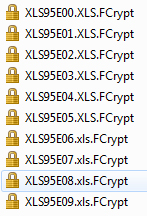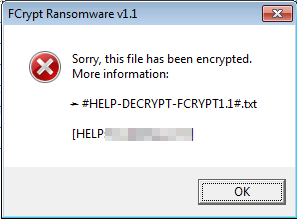Ransom.Win32.FCRYPT.THBAAAI
VBS/KillBackup.B trojan, VBS/KillBackup.B trojan, VBS/KillBackup.B trojan(NOD32);
Windows


Threat Type: Ransomware
Destructiveness: No
Encrypted: No
In the wild: Yes
OVERVIEW
Downloaded from the Internet, Dropped by other malware
This Ransomware arrives on a system as a file dropped by other malware or as a file downloaded unknowingly by users when visiting malicious sites.
It encrypts files with specific file extensions. It drops files as ransom note.
TECHNICAL DETAILS
2,042,880 bytes
EXE
No
11 Feb 2019
Deletes files, Adds registry
Arrival Details
This Ransomware arrives on a system as a file dropped by other malware or as a file downloaded unknowingly by users when visiting malicious sites.
Installation
This Ransomware drops the following files:
- %User Temp%\{8random characters}.bat;
- %User Temp%\qb{6random characters}.{2random characters}\delsc.vbs;
- %User Temp%\qb{6random characters}.{2random characters}\FCrypt.txt.tmp;
- %User Temp%\qb{6random characters}.{2random characters}\FCRYPT_RSA_PUBLIC_KEY.TMP;
- %User Temp%\qb{6random characters}.{2random characters}\gpg.exe;
- %User Temp%\qb{6random characters}.{2random characters}\gpg-agent.exe;
- %User Temp%\qb{6random characters}.{2random characters}\libassuan-0.dll;
- %User Temp%\qb{6random characters}.{2random characters}\libgcrypt-20.dll;
- %User Temp%\qb{6random characters}.{2random characters}\libgpg-error-0.dll;
- %User Temp%\qb{6random characters}.{2random characters}\libgpgme-11.dll;
- %User Temp%\qb{6random characters}.{2random characters}\libksba-8.dll;
- %User Temp%\qb{6random characters}.{2random characters}\libnpth-0.dll;
- %User Temp%\qb{6random characters}.{2random characters}\libsqlite3-0.dll;
- %User Temp%\qb{6random characters}.{2random characters}\md5.exe;
- %User Temp%\qb{6random characters}.{2random characters}\svchost.exe;
- %User Temp%\qb{6random characters}.{2random characters}\zlib1.dll;
- %User Temp%\FCRYPT.KEY;
- %User Temp%\#HELP-DECRYPT-FCRYPT1.1#.txt;
- %User Temp%\FCRYPT_VICTIM.TMP;
- %Desktop%\#HELP-DECRYPT-FCRYPT1.1#.txt;
(Note: %User Temp% is the current user's Temp folder, which is usually C:\Documents and Settings\{user name}\Local Settings\Temp on Windows 2000, XP, and Server 2003, or C:\Users\{user name}\AppData\Local\Temp on Windows Vista, 7, and 8.. %Desktop% is the current user's desktop, which is usually C:\Documents and Settings\{User Name}\Desktop on Windows 2000, XP, and Server 2003, or C:\Users\{user name}\Desktop on Windows Vista, 7, and 8.)
It adds the following processes:
- cmd.exe /c ""%User Temp%\{8random characters}.bat" {malware filename}.exe"
- %User Temp%\qb{6random characters}.{2random characters}\svchost.exe -e {random generated md5 hash} "{target file}" "{targetfile}.FCrypt" - for every file targeted
(Note: %User Temp% is the current user's Temp folder, which is usually C:\Documents and Settings\{user name}\Local Settings\Temp on Windows 2000, XP, and Server 2003, or C:\Users\{user name}\AppData\Local\Temp on Windows Vista, 7, and 8.)
It creates the following folders:
- %User Temp%\qb{6random characters}.{2random characters}
(Note: %User Temp% is the current user's Temp folder, which is usually C:\Documents and Settings\{user name}\Local Settings\Temp on Windows 2000, XP, and Server 2003, or C:\Users\{user name}\AppData\Local\Temp on Windows Vista, 7, and 8.)
Other System Modifications
This Ransomware deletes the following files:
- %User Temp%\{8random characters}.bat;
- %User Temp%\qb{6random characters}.{2random characters}\delsc.vbs;
- %User Temp%\qb{6random characters}.{2random characters}\FCrypt.txt.tmp;
- %User Temp%\qb{6random characters}.{2random characters}\FCRYPT_RSA_PUBLIC_KEY.TMP;
- %User Temp%\qb{6random characters}.{2random characters}\gpg.exe;
- %User Temp%\qb{6random characters}.{2random characters}\libgpgme-11.dll;
- %User Temp%\qb{6random characters}.{2random characters}\libksba-8.dll;
- %User Temp%\qb{6random characters}.{2random characters}\libsqlite3-0.dll;
- %User Temp%\qb{6random characters}.{2random characters}\md5.exe;
- %User Temp%\qb{6random characters}.{2random characters}\svchost.exe;
- %User Temp%\qb{6random characters}.{2random characters}\zlib1.dll;
(Note: %User Temp% is the current user's Temp folder, which is usually C:\Documents and Settings\{user name}\Local Settings\Temp on Windows 2000, XP, and Server 2003, or C:\Users\{user name}\AppData\Local\Temp on Windows Vista, 7, and 8.)
It adds the following registry keys:
HKEY_LOCAL_MACHINE\SOFTWARE\Classes\
FCRYPT\Shell\Open\
Command
HKEY_LOCAL_MACHINE\SOFTWARE\Classes\
FCRYPT\DefaultIcon
{default} = C:\Windows\System32\shell32.dll,-48
HKEY_LOCAL_MACHINE\SOFTWARE\Classes\
.FCrypt
{default} = FCRYPT
HKEY_CURRENT_USER\Software\Microsoft\
Windows\CurrentVersion\Run
FCRYPT1 = notepad %User Temp%\#HELP-DECRYPT-FCRYPT1.1#.txt"
HKEY_CURRENT_USER\Software\Microsoft\
Windows\CurrentVersion\Run
FCRYPT2 = attrib -h C:\Users\dyituser_732\Desktop\#HELP-DECRYPT-FCRYPT1.1#.txt
HKEY_CURRENT_USER\Software\Microsoft\
Windows\CurrentVersion\Run
FCRYPT3 = copy %User Temp%\#HELP-DECRYPT-FCRYPT1.1#.txt %Desktop%\#HELP-DECRYPT-FCRYPT1.1#.txt
Other Details
This Ransomware does the following:
- The malware changes the icon of the files it encrypts

- Upon opening an encrypted file, a message box appears

Ransomware Routine
This Ransomware encrypts files with the following extensions:
- .xls
- .doc
- .xlsx
- .docx
- .rtf
- .cdr
- .psd
- .dwg
- .cd
- .mdb
- .1cd
- .dbf
- .sqlite
- .jpg
- .jpeg
- .zip
- .bmp
- .txt
- .rar
- .mp4
- .sql
- .c
- .cpp
- .java
- .php
- .asp
- .svg
- .psd
- .bak
- .html
It appends the following extension to the file name of the encrypted files:
- .Fcrypt
It drops the following file(s) as ransom note:
- %Desktop%\#HELP-DECRYPT-FCRYPT1.1#.txt

SOLUTION
9.850
14.806.02
11 Feb 2019
14.807.00
12 Feb 2019
Step 1
Before doing any scans, Windows 7, Windows 8, Windows 8.1, and Windows 10 users must disable System Restore to allow full scanning of their computers.
Step 2
Note that not all files, folders, and registry keys and entries are installed on your computer during this malware's/spyware's/grayware's execution. This may be due to incomplete installation or other operating system conditions. If you do not find the same files/folders/registry information, please proceed to the next step.
Step 3
Restart in Safe Mode
Step 4
Delete this registry key
Important: Editing the Windows Registry incorrectly can lead to irreversible system malfunction. Please do this step only if you know how or you can ask assistance from your system administrator. Else, check this Microsoft article first before modifying your computer's registry.
- In HKEY_LOCAL_MACHINE\SOFTWARE\Classes\.FCrypt
- {default} = FCRYPT;
- {default} = FCRYPT;
- In HKEY_LOCAL_MACHINE\SOFTWARE\Classes\FCRYPT\DefaultIcon
- {default} = C:\Windows\System32\shell32.dll,-48
- {default} = C:\Windows\System32\shell32.dll,-48
- In HKEY_CURRENT_USER\Software\Microsoft\Windows\CurrentVersion\Run
- FCRYPT1 = notepad %User Temp%\#HELP-DECRYPT-FCRYPT1.1#.txt"
- FCRYPT1 = notepad %User Temp%\#HELP-DECRYPT-FCRYPT1.1#.txt"
- In HKEY_CURRENT_USER\Software\Microsoft\Windows\CurrentVersion\Run
- FCRYPT2 = attrib -h C:\Users\dyituser_732\Desktop\#HELP-DECRYPT-FCRYPT1.1#.txt
- FCRYPT2 = attrib -h C:\Users\dyituser_732\Desktop\#HELP-DECRYPT-FCRYPT1.1#.txt
- In HKEY_CURRENT_USER\Software\Microsoft\Windows\CurrentVersion\Run
- FCRYPT3 = copy %User Temp%\#HELP-DECRYPT-FCRYPT1.1#.txt C:\Users\dyituser_732\Desktop\#HELP-DECRYPT-FCRYPT1.1#.txt;
- FCRYPT3 = copy %User Temp%\#HELP-DECRYPT-FCRYPT1.1#.txt C:\Users\dyituser_732\Desktop\#HELP-DECRYPT-FCRYPT1.1#.txt;
Step 5
Search and delete this folder
- %User Temp%\qb{6random characters}.{2random characters}
Step 6
Search and delete these files
- %Desktop%\#HELP-DECRYPT-FCRYPT1.1#.txt
- %User Temp%\FCRYPT.KEY
- %User Temp%\#HELP-DECRYPT-FCRYPT1.1#.txt
- %User Temp%\FCRYPT_VICTIM.TMP
Step 7
Restart in normal mode and scan your computer with your Trend Micro product for files detected as Ransom.Win32.FCRYPT.THBAAAI. If the detected files have already been cleaned, deleted, or quarantined by your Trend Micro product, no further step is required. You may opt to simply delete the quarantined files. Please check this Knowledge Base page for more information.
Step 8
Restore encrypted files from backup.
Did this description help? Tell us how we did.

